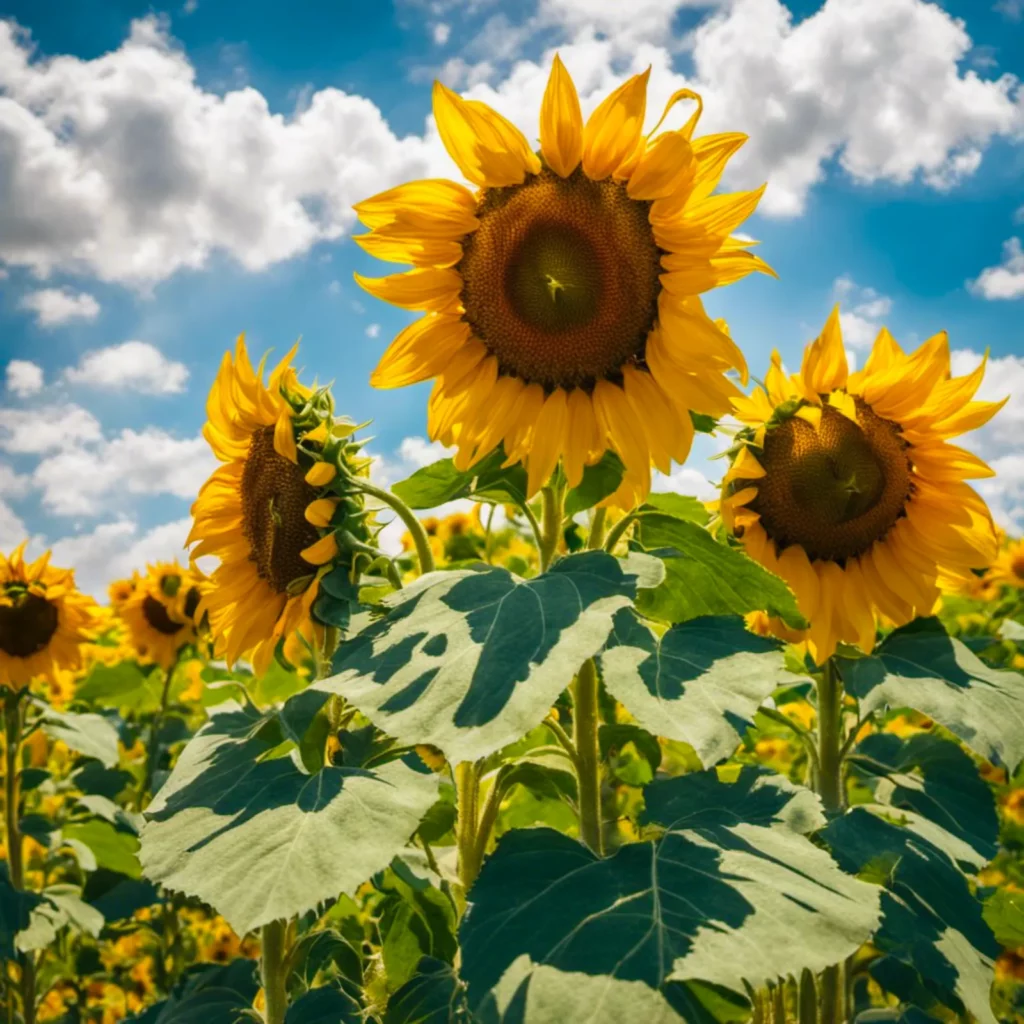Sunflower vs Yellow Daisy: A Comparison of Two Popular Garden Flowers
Looking to add color to your garden? Two popular options are sunflowers and yellow daisies. While they may appear similar, they have distinct differences.
Sunflowers are known for their tall, sturdy stems, reaching up to 15 feet, with single large flower heads containing many small flowers surrounded by yellow or brown petals.
Yellow daisies are smaller, with multiple small flower heads on short stems, usually 6-12 inches in height. Understanding these distinctions will help you choose the right flower for your garden.

Sunflower vs Yellow Daisy
If you’re looking to add some color and vibrancy to your garden, both sunflowers and yellow daisies are great options. But which one should you choose? Let’s take a closer look at the differences between these two iconic flowers.
Appearance
Sunflowers are known for their large, vibrant flowers that can grow up to a foot in diameter. They’re like a ray of sunshine in your garden.
Yellow daisies, on the other hand, are more modest in size, with flowers typically ranging from 1 to 3 inches in diameter. While sunflowers have a single large flower head on a long stem, daisies are smaller plants with multiple small flower heads on short stems.
Growing Conditions
Sunflowers are annual plants that require full sun and well-draining soil. They also need plenty of water during the growing season.
Yellow daisies, on the other hand, are perennial plants that can tolerate some shade and prefer moist, well-draining soil. They require less water than sunflowers and can even tolerate drought conditions.
Maintenance
Both sunflowers and yellow daisies are relatively low-maintenance plants. However, sunflowers may require staking to prevent them from toppling over due to their height and weight.
Yellow daisies, on the other hand, may require deadheading to encourage continued blooming throughout the season.
Uses
Sunflowers are often grown for their edible seeds, which are rich in protein and healthy fats.
They can also be used as a natural dye or in birdseed mixtures. Yellow daisies, on the other hand, are often used in cut flower arrangements or as a border plant in gardens.
Understanding Sunflowers

Sunflowers are one of the most recognized and beloved flowers in the world. They are known for their bright yellow petals and large brown centers. In this section, we will explore the origin, characteristics, cultivation, and care of sunflowers.
Origin of Sunflowers
Sunflowers are native to North America, specifically to the Great Plains region. They were first cultivated by Native Americans over 1000 years ago.
The sunflower was an important crop for the Native Americans, who used it for food, oil, and medicine. The sunflower was eventually brought to Europe by Spanish explorers in the 16th century.
Characteristics of Sunflowers
Sunflowers are a member of the Asteraceae family and are scientifically known as Helianthus annuus. They can grow up to 15 feet tall, making them a towering presence in any garden.
Sunflowers have a tall and sturdy stem, which can be either single or branching. The stem is covered in coarse hair and has a rough texture. The leaves of the sunflower are long and thin, and they grow alternately along the stem.
The flower head of the sunflower is made up of many small flowers surrounded by yellow or brown petals. The center of the flower head is a large brown disk that contains the seeds. Sunflowers come in a variety of colors, including yellow, red, mahogany, and bicolors.
Cultivation and Care of Sunflowers
Sunflowers are easy to grow and care for, making them a popular choice for gardeners of all levels. They prefer full sun and well-drained soil. Sunflowers can be grown from seed, which should be planted in the spring after the last frost. The seeds should be planted 1-2 inches deep and 6 inches apart.
Sunflowers require regular watering, especially during hot and dry weather. They should be watered deeply once a week, rather than receiving shallow watering more frequently. Sunflowers should also be fertilized every 4-6 weeks with a balanced fertilizer.
Sunflowers can attract birds and other wildlife to your garden, so it’s important to protect them from pests. You can use natural pest control methods, such as planting companion plants or using insecticidal soap, to keep your sunflowers healthy.
Understanding Yellow Daisies

Yellow daisies are a beautiful and popular flower that are often grown in gardens and used in floral arrangements. In this section, we’ll take a closer look at the origin, characteristics, cultivation, and care of yellow daisies.
Origin of Yellow Daisies
Yellow daisies belong to the Asteraceae family, which is one of the largest families of flowering plants. They are native to Europe, Asia, and North America, and have been cultivated for centuries for their beauty and medicinal properties.
Characteristics of Yellow Daisies
Yellow daisies are known for their bright yellow petals and dark yellow centers, which can be single or double. They typically bloom in the summer and fall, and can grow up to 12 inches tall. They have a delicate stem that can be easily broken, so care must be taken when handling them.
Yellow daisies are also known for their medicinal properties. They contain compounds that have been shown to have anti-inflammatory, antioxidant, and antimicrobial properties.
Cultivation and Care of Yellow Daisies
Yellow daisies are relatively easy to grow and care for. They prefer well-drained soil and full sun, but can also tolerate partial shade. They should be watered regularly, but not over-watered, as this can cause the roots to rot.
Yellow daisies can be propagated by seeds or cuttings. Seeds should be sown in the spring or fall, and cuttings should be taken in the summer. They should be planted in a location that receives at least 6 hours of sunlight per day.
When planting yellow daisies, it’s important to space them at least 6 inches apart to allow for proper growth. They should also be fertilized every 2-3 weeks with a balanced fertilizer.
Comparative Analysis
When it comes to choosing between sunflowers and yellow daisies for your garden, there are several factors to consider. In this section, we will compare the appearance, growth and care, and symbolism of these two iconic flowers.
Appearance Comparison
Sunflowers and yellow daisies have distinct differences in appearance. Sunflowers have a tall and sturdy stem, which can be either single or branching. They can grow up to 15 feet tall, making them a towering presence in any garden.
The flower head of a sunflower comprises many small flowers surrounded by yellow or brown petals. On the other hand, yellow daisies have shorter, more delicate stems, usually reaching a height of 6-12 inches.
They have multiple small flower heads on short stems, and their petals are typically white or yellow.
Growth and Care Comparison
When it comes to growing and caring for sunflowers and yellow daisies, there are some notable differences.
Sunflowers are annual plants, meaning they need to be replanted from seed each year. They require full sun exposure, well-draining soil, and regular watering. Sunflowers also benefit from fertilization and may need staking to support their tall stems.
Yellow daisies, on the other hand, are perennial plants, meaning they come back each year. They are also more adaptable to different growing conditions and can tolerate partial shade.
Yellow daisies need well-draining soil and regular watering, but they do not require as much fertilizer as sunflowers. They also do not need staking as their stems are shorter and more delicate.
Symbolism Comparison
Sunflowers and yellow daisies have different symbolic meanings. Sunflowers are often associated with loyalty, longevity, and adoration.
They are also a symbol of happiness, positivity, and good luck. Yellow daisies, on the other hand, are often associated with innocence, purity, and new beginnings. They are also a symbol of cheerfulness, optimism, and joy.
FAQs
Are Sunflowers and Yellow Daisies the same?
Nope! While both belong to the Asteraceae family, they come from different genera (Helianthus and Bellis Perennis, respectively) and have unique characteristics that set them apart.
Can Sunflowers and Yellow Daisies be planted together?
Absolutely! Just be mindful of their differing heights and sunlight needs. Plant Sunflowers towards the back of the garden, and Yellow Daisies closer to the front to create an eye-catching layered effect.
How long do Sunflowers and Yellow Daisies bloom?
Sunflowers typically bloom for about 2-3 months in the summer, while Yellow Daisies can bloom from spring to fall, depending on the variety and growing conditions.
Are Sunflowers and Yellow Daisies toxic to pets?
While Sunflowers are non-toxic to pets, some parts of the Yellow Daisy plant can be toxic to dogs and cats if ingested in large quantities. It’s best to keep an eye on your furry friends when they’re around these plants.
Conclusion
Sunflowers and yellow daisies are two of the most iconic and beloved flowers in the world, each with their own unique features and uses. Whether you prefer the bold and showy sunflower or the delicate and feminine yellow daisy, both flowers have something to offer.
When deciding between sunflowers and yellow daisies, consider factors like size, growing conditions, and symbolism, as well as your own personal preferences and needs. No matter which flower you choose, you can’t go wrong with these iconic and timeless blooms.
Related Posts:






